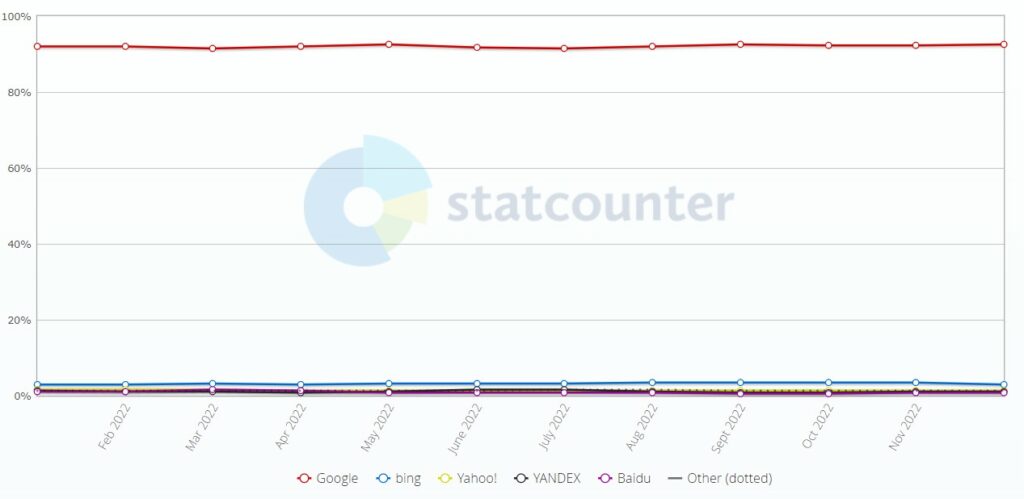*This article was last updated on 11/07/2023
Search engine algorithms are the heart and soul of the internet. They work quietly behind the scenes to organize a vast web of information. They’re the reason you can type a question into Google and receive an answer in milliseconds.
Understanding these algorithms isn’t just a fun intellectual exercise—getting your content seen is essential. By the end of this journey, I hope you’ll understand these algorithms and how they work and learn the basics of creating SEO-optimized content for your website.
What Are Search Engine Algorithms?
A search engine algorithm is a set of rules and calculations. They guide the search engine in determining which websites to present when you input a query. These algorithms are the silent navigators of our daily internet journeys.
However, if you’re picturing some static, unchanging rules, I’m afraid I must burst that bubble. These algorithms have evolved and changed since the first search engine was born.
Remember the good old days of Ask Jeeves and AltaVista? The algorithms of those times were rudimentary compared to the sophisticated systems we have today. They’ve evolved from simple keyword matching to complex computations considering hundreds of factors.
How Search Engines Work: Crawling, Indexing, and Ranking
Understanding the world of search engine algorithms requires us to delve deeper into their primary functions. The process can be distilled into three key stages: crawling, indexing, and ranking. Let’s explore each one in detail to understand better how they contribute to the whole.
1. Crawling: Dredging Masses of Data From The Web
The first step in the journey of a search query begins with ‘crawling.’ Picture an army of diligent digital spiders dispatched by the search engine to journey across the vast expanses of the internet.
These web crawlers, or spiders, have a critical mission: to scour every accessible corner of the World Wide Web, trawling through webpages, PDFs, documents, and other publicly available content.
Crawling is not a one-time process but a continuous endeavor. The spiders keep revisiting websites to check for updates or new pages, ensuring the search engine’s data is as current. The constant exploration forms the foundation for the rest of the search engine algorithm process.
2. Indexing: Organizing The Digital Library
Once the digital spiders have collected the data, the next step is ‘indexing.’ This process is akin to a librarian sorting through a mountain of books and neatly arranging them on the right shelves.
In the indexing phase, the search engine processes the data gathered by the crawlers and organizes it into a colossal database. This database—or ‘index’—is like a vast digital library. That library contains a copy of every webpage the spiders have found.
The index is continuously updated as new information is crawled, ensuring that the search engine’s results reflect the current state of the web.
3. Ranking: Deciding Which Pages Get Top Spots
The final stage in this journey is ‘ranking.’ Here, the search engine decides which web pages are the most relevant to your query and presents them to you in a ranked list. The determination isn’t random. It is based on a complex set of ranking factors that the algorithm calculates.
These factors also contribute the most to the average SEO practitioner’s headaches. There are many factors, each with individual weightage of importance. For example, some known factors are keyword relevance, content quality, and inbound links. But more on this later.
These three stages—crawling, indexing, and ranking—form the crux of search engine algorithms’ operation. They work together seamlessly, providing you with the information you need at a moment’s notice.
Factors That Influence Search Engine Algorithms

Peeling back the layers of search engine algorithms, several vital factors influence how they operate. These elements are crucial in determining which content gets to bask in the spotlight and which gets left in the shadows.
Let’s dive into these components and understand how they shape the world of search engine rankings.
Relevance: The Keyword Connection
One of the most fundamental elements algorithms consider is keyword relevance. When you type a query into a search engine, it looks for content that includes those keywords. But it doesn’t stop there.
Modern algorithms go beyond simple keyword matching to understand the context and intent behind your search, providing more accurate and relevant results.
Quality: Content is King
Another crucial factor is the quality of the content. Search engines strive to provide users with the best possible results, prioritizing high-quality, valuable, and informative content. They assess this through various means, such as the length and depth of the content, the use of relevant visuals, the structure of the text, and even grammar and spelling.
User Experience: Meeting The Expectations of Audiences
Search engines are designed with the end user in mind. This means they consider factors that contribute to a positive user experience. For instance, fast, mobile-friendly, and easily navigable sites are favored.
User engagement metrics, like the average time spent on a page or the bounce rate, can influence rankings.
Trustworthiness: Building Confidence
Credibility and trust are critical in the digital world. Search engines assess a site’s trustworthiness in various ways, such as checking if the site is secure (HTTPS), whether it has high-quality inbound and outbound links, and if it provides accurate and reliable information.
Personalization: Tailoring the Results
One-size-fits-all has become increasingly obsolete, even in search engines. The results you see when you search are explicitly tailored to you. Modern search engines personalize results based on the user’s location, search history, and settings. This means two people can search for the same term and get different results.
Navigating The Complexities of SEO
Embarking on an SEO journey can be akin to navigating a labyrinth, with twists, turns, and occasional dead-ends. The world of search engine algorithms is complex and ever-evolving, and keeping up with the changes can feel like chasing a moving target.
But fear not. While the path may be challenging, it’s undoubtedly navigable, and the rewards can be significant. Keeping a few noble truths in mind is vital to a positive SEO experience.
Understand That SEO is Constantly Evolving
One of the key complexities of SEO lies in the dynamic nature of search engine algorithms. As we’ve seen, search engines like Google frequently update their algorithms, refining their processes and criteria to provide better, more relevant search results.
These changes can sometimes shift the SEO landscape, requiring website owners and SEO professionals to adapt their strategies. For instance, an algorithm update might emphasize a particular ranking factor, like mobile-friendliness or site speed.
Websites previously well-optimized might drop their rankings if they don’t meet this new criterion. Conversely, sites that adapt quickly can seize the opportunity to climb the rankings.
Balance User Needs and Algorithm Requirements
Another complexity in SEO lies in striking the right balance between optimizing for search algorithms and meeting the needs of your audience. After all, the ultimate goal is not just to rank highly in search results but to attract and engage your target audience.
This balancing act requires a deep understanding of your audience and the search engine algorithms. You must create content that resonates with your audience, answering their questions and providing valuable information.
However, it’s essential that you also incorporate SEO best practices to ensure that search engines quickly discover your content.
Technical SEO is a Thing
Technical SEO is another area where complexities abound. This involves optimizing your website’s technical aspects, such as site speed, mobile-friendliness, and secure connections, to enhance its visibility to search engines.
While these elements may not be visible to your users, they are crucial in how search engines crawl, index, and rank your site.
Navigating these technicalities requires certain technical expertise or a willingness to learn and experiment. It also requires staying up-to-date with the latest best practices and guidelines from search engines.
Google Search Algorithms: The Big Bad Wolf of Search

As we venture deeper into the world of search engine algorithms, it’s impossible to ignore the giant in the room: Google. Holding the lion’s share of the search market, Google’s algorithms have become the gold standard for SEO practitioners.
Its iron grip over search is firm and consistent, handling over 90% of all search queries online. Any SEO practitioner knows that search optimization primarily means meeting the needs of Google. And Google certainly does not make things easy.
What Drives Google’s Search Algorithms?
At the heart of Google’s algorithms lies a core philosophy: a relentless focus on the user. Each component of Google’s complex algorithmic system is designed to understand and cater to the user’s needs, striving to deliver the most relevant and high-quality results for every query.
Relevance is the name of the game here. When you type a query into Google, its algorithms swing into action, sifting through billions of web pages in its index to find the ones most relevant to your search.
But it’s about more than just matching the keywords in your query. Google’s algorithms go beyond trying to understand the intent behind your search, ensuring that the results you see align with what you’re looking for.
There is Constant Evolution in Google Algorithms
One of the defining characteristics of Google’s algorithms is their constant evolution. Google frequently updates its algorithms, making small tweaks and adjustments to improve the search experience.
Sometimes, these are minor changes that go unnoticed. But occasionally, Google rolls out major updates that significantly affect search rankings and SEO practices.
These updates reflect Google’s continuous efforts to improve the quality and relevance of its search results. They also highlight the dynamic nature of the digital landscape, where new types of content, new user behaviors, and new technologies continually emerge and shape how we interact with the web.
Major Google Algorithm Updates: Shaping the SEO Landscape
Over the years, Google has rolled out several significant algorithm updates. Each update brought changes that shook the SEO world and pushed website owners to adapt their strategies.
Let’s take a closer look at some of the most impactful updates.
Panda
Launched in 2011, the Panda update aimed to lower the rank of “low-quality sites” or “thin sites” and return higher-quality sites near the top of the search results. It encouraged website owners to focus on creating valuable, unique, high-quality content, marking a significant shift towards content quality over quantity.
Penguin
Gogole’s Penguin update rolled out in 2012, targeting websites spamming search results by buying links or obtaining them through link networks designed primarily to boost Google rankings. This update underscored the importance of having a natural, high-quality backlink profile.
Hummingbird
Introduced in 2013, Hummingbird was designed to better interpret the intent behind a user’s search, focusing on understanding the context and meaning of the search terms rather than just individual keywords. This made it easier for users to find what they’re looking for, even if they don’t know how to say it.
RankBrain
Launched in 2015, RankBrain is a machine learning-based algorithm that helps Google understand the meaning behind queries and serves best-matching search results. It made Google’s search process much more intelligent and adaptable.
BERT
The most recent significant update, BERT (Bidirectional Encoder Representations from Transformers), was rolled out in 2019. It uses Natural Language Processing (NLP) technology better to understand the nuances and context of words in searches and match those queries with more relevant results.
Adapting to Google Search Algorithm Changes
Understanding the nature and purpose of Google’s algorithm updates is essential for anyone looking to optimize their content for this search engine giant. It underscores the importance of creating high-quality, valuable content that provides a positive user experience while emphasizing the need for a solid and natural backlink profile.
These updates also highlight the increasing sophistication of Google’s algorithms as they move towards understanding the intent and context of searches rather than simply matching keywords.
As we move forward, it’s crucial to stay updated on these changes and adapt our SEO strategies accordingly.
The Future of Search: The Era of Artificial Intelligence
Artificial Intelligence (AI) has become integral to modern search engines, significantly enhancing their capabilities and user experience. AI enables search engines to understand and process complex queries, provide precise and relevant results, and interact more sophisticatedly with users.
Large tech companies like Google and Microsoft have been at the forefront of integrating AI into their search engines, pushing the boundaries of what’s possible in information retrieval and interaction. That’s how we’ve ended up with the examples below, practically appearing overnight;
Google Bard
One of the most notable advancements in AI-driven search is Google’s experimental conversational AI service, Bard. It is powered by Google’s Language Model for Dialogue Applications (LaMDA).
Bard seeks to combine the breadth of the world’s knowledge with large language models’ power, intelligence, and creativity. It draws on information from the web to provide fresh, high-quality responses and aims to be an outlet for creativity and a launchpad for curiosity.
The service was initially released with a lightweight model version of LaMDA that requires significantly less computing power, enabling it to scale to more users and allowing for more feedback.
Google also plans to bring its newest AI technologies, such as LaMDA, PaLM, Imagen, and MusicLM, into its everyday products, starting with Search. Soon, AI-powered features in Search will distill complex information and multiple perspectives into easy-to-digest formats, so users can quickly understand the big picture and learn more from the web.
Bing Chat
Microsoft’s Bing search engine has also integrated AI into its platform with the introduction of Bing Chat, built into the Microsoft Edge sidebar. This feature allows users to ask complex questions and find comprehensive answers while browsing the web without switching between tabs.
It can perform searches and provide answers about the page viewed, which could be especially useful when seeking contextual information. Bing Chat is also slated to be available on the Edge mobile app shortly.
Concluding Thoughts: The Importance of Understanding SEO
Understanding search engine algorithms is not just for the tech-savvy or the SEO professional – it’s an invaluable knowledge base for anyone keen to make their online presence felt. By familiarizing ourselves with the fundamentals of search engines, we can optimize our content to be more accessible and appealing to these digital gatekeepers.
The world of search engine algorithms is one of constant evolution. Staying informed and being prepared to adapt is crucial. Our visibility strategies must evolve as the algorithms become more intelligent and sophisticated.
After all, SEO is not a one-time fix but a long-term commitment to delivering quality and value to our audience.
Need help with your website SEO? Let’s talk!

